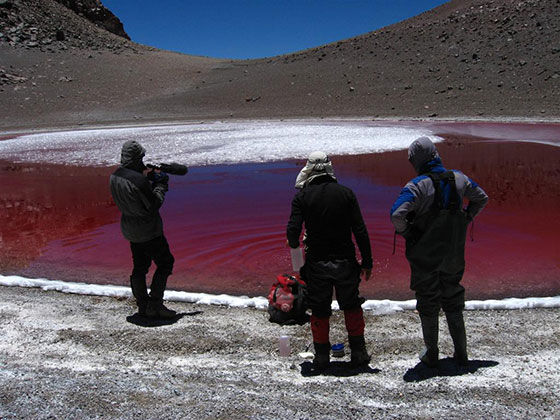-
The Search for Mars Biosignatures Up at High Altitudes
February 07, 2017 / Posted by: Miki Huynh
Summit of the Simba volcano (19,400 ft) – The summit crater lake is shallow and its water column completely transparent. The red color of the lake is from an algae that has developed special pigments in response to extreme levels of short wavelength (UVA and UVB) radiation. Source: SETI Institute/ NAI High Lakes ProjectFrom October through November 2016, Nathalie Cabrol, director of the Carl Sagan Center at the SETI Institute, with members of the NASA Astrobiology Institute team based at SETI, went on a month-long expedition to Chile, visiting Mars-analogue sites between 800 and 6,000 km above sea level to collect samples and test in situ instruments in preparation for the Mars 2020 and ExoMars science payloads.
Photos and posts from the field sites written by Nathalie Cabrol are available at the SETI institute website, and are linked to below.
The Search for Biosignatures on Mars Starts High on Earth: http://www.seti.org/seti-institute/aiming-high-the-search-for-biosignatures-on-mars-starts-high-on-earth.
Hello from Salar Grande: http://www.seti.org/seti-institute/salar-grande
Welcome to Salar Grande: http://www.seti.org/seti-institute/welcome-to-salar-grande
Dr. Cabrol Visits Expedition Site 2 in the Andes: http://www.seti.org/seti-institute/Dr-Cabrol-visits-Expedition-Site-2-Andes
Chile Expedition 2016 Album 3: http://www.seti.org/seti-institute/chile-expedition-2016/album-3
The samples taken from the field study are currently being characterized by SETI and the University of Montana, with future talks planned to present the research findings.

The SETI scientist camp site at Salar Grande. Domes and tents consist of personal tents, dining/working areas, kitchen, and a lab. Source: Victor Robles Bravo, Campoalto/SETI InstituteSource: [SETI]
- The NASA Astrobiology Institute Concludes Its 20-year Tenure
- Global Geomorphologic Map of Titan
- Molecular Cousins Discovered on Titan
- Interdisciplinary Consortia for Astrobiology Research (ICAR)
- The NASA Astrobiology Science Forum Talks Now on YouTube
- The NASA Astrobiology Science Forum: The Origin, Evolution, Distribution and Future of Astrobiology
- Alternative Earths
- Drilling for Rock-Powered Life
- Imagining a Living Universe
- Workshops Without Walls: Astrovirology